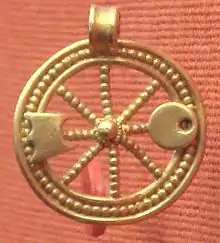In Gallo-Roman religion, Damona was a goddess worshipped in Gaul as the consort of Apollo Borvo and of Apollo Moritasgus.
Name
The theonym Damona is a derivative of the Proto-Celtic stem *damo-, meaning 'bull' or 'deer' (cf. Old Irish dam 'bull, deer'; also *damato- > Middle Welsh dafad 'sheep', Old Cornish dauat 'ewe'), itself from Proto-Indo-European *dmh2o- ('the tamed one'). The Latin noun damma, which is the source of French daim ('roe'), is probably a loanword from Gaulish. The root *dmh2- is also presumably reflected in the British tribal name Demetae, interpreted as meaning 'Tamers'.[1][2]
Cult

Damona and Bormana have been described as the patron deities of the hot springs at Bourbonne-les-Bains and Saint-Vulbas, respectively.[3][4] Some seventeen inscriptions dedicated to Damona have been recovered, including nine from Bourbonne-les-Bains and four from Bourbon-Lancy, both spa towns in eastern France. In one inscription from Saintes, she has the epithet Matubergini.[5]
Inscriptions and dedications
There are several inscriptions relating to Damona,[6] including two inscriptions in Bourbon-Lancy (CIL 13, 02805), discovered in 1792.
- C (aius) Iulius Eporedirigis f (ilius) Magnus / pro L (ucio) Iulio Caleno filio / Bormoni and Damonae / vot (um) sol (vit)
and (CIL 13, 02806), where Damona is also included in dedications to Borvo, (CIL 13, 02807) and (CIL 13, 02808):
- Borvoni and Damonae / T (itus) Severius Mo / destus [o] mnib (us) / h [o] n [orib (us)] and offi [ciis]
The other large site associated with Damona is Bourbonne-les-Bains, there are nine dedications to the goddess of the waters, including (CIL 13, 05911):
- Deo Apol / lini Borvoni / et Damonae / C (aius) Daminius / Ferox civis / Lingonus ex / voto
and (CIL 13, 05914):
- Borvoni / and Damon (ae) / Aemilia / Sex (ti) fil (ia) / M [3] S
with (CIL 13, 05921):
- Damonae Aug (ustae) / Claudia Mossia and C (aius) Iul (ius) Superstes fil (ius) / l (ocus) d (atus) ex d (ecreto) d (ecurionum) v (otum) s (olverunt) l ( ibentes) m (erito)
Damona also appears in dedications to Chassenay, associated with Albius and Alise-Sainte-Reine. An inscription was found bearing Damona's name in Alesia in 1962, where she was worshipped with Apollo Moritasgus[7][8][9] (CIL 13, 11233):
- Aug (usto) sacr (um) / deo Albio and Damonae Sex (tus) Mart (ius) / Cocillus ex iussu eius v (otum) s (olvit) l (ibens) m (erito)
and (CAG-21-01):
- Deo Apollini Moritasgo [and] / Damonae P (ublius) Pontius Apolli [naris]
Finally, there is an inscription in Rivières.[10]
Jullia Malla Malluronis fîl (ia) numinibus Augustorum et deae Damonae Matuherginni (?) Ob memoriam Sulpiciae Silvanae filiae suae de suo posuit
References
- ↑ Delamarre 2003, p. 135.
- ↑ Matasović 2009, p. 89.
- ↑ MacKillop, James (2016). A dictionary of Celtic mythology. Oxford. ISBN 978-0-19-880484-0. OCLC 965737514.
{{cite book}}: CS1 maint: location missing publisher (link) - ↑ William van Andringa (2002). La religion en Gaule romaine : Piété et politique (Ier-IIIe siècle apr. J.-C.) Editions Errance, Paris. p.165
- ↑ Nicole Jufer & Thierry Luginbühl (2001). Les dieux gaulois : répertoire des noms de divinités celtiques connus par l'épigraphie, les textes antiques et la toponymie. Editions Errance, Paris. pp.36-7.
- ↑ Hatt, Jean-Jacques (1983). "Apollon guérisseur en Gaule. Ses origines, son caractère, les divinités qui lui sont associées - Chapitre II". Revue archéologique du Centre de la France. 22 (3): 185–218. doi:10.3406/racf.1983.2383.
- ↑ Le Gall, Joël. (1980). Alésia : archéologie et histoire (Nouv. éd. rev. et augm ed.). [Paris]: Fayard. ISBN 2-213-00780-2. OCLC 7462836.
- ↑ Raepsaet-Charlier, Marie-Thérèse (2013). "Alésia et ses dieux:: du culte d'Apollon Moritasgos à l'appartenance civique des Mandubiens à l'époque gallo-romaine". L'Antiquité Classique. 82: 165–194. doi:10.3406/antiq.2013.3831. ISSN 0770-2817. JSTOR 90004373.
- ↑ Beck, Noémie (2009). Goddesses in Celtic Religion: Cult and Mythology: A Comparative Study of Ancient Ireland, Britain and Gaul. Lyon, France.
{{cite book}}: CS1 maint: location missing publisher (link) - ↑ Héron de Villefosse, Antoine (1918). "Inscription romaine de Rivières (Charente)". Comptes rendus des séances de l'Académie des Inscriptions et Belles-Lettres. 62 (6): 479–484. doi:10.3406/crai.1918.74083.
Bibliography
- Delamarre, Xavier (2003). Dictionnaire de la langue gauloise: Une approche linguistique du vieux-celtique continental. Errance. ISBN 9782877723695.
- Matasović, Ranko (2009). Etymological Dictionary of Proto-Celtic. Brill. ISBN 9789004173361.

